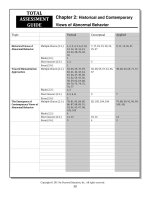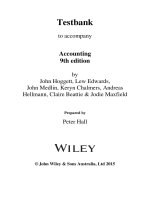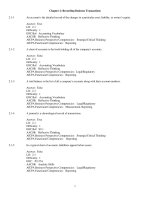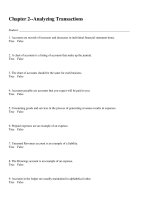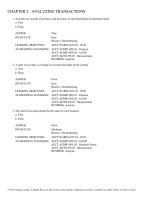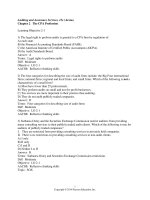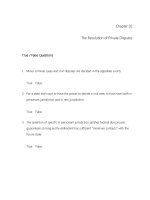Managerial accounting 15th edition garrison test bank
Bạn đang xem bản rút gọn của tài liệu. Xem và tải ngay bản đầy đủ của tài liệu tại đây (2.49 MB, 243 trang )
Difficulty
E
E
M
H
E
M
M
E
E
E
E
M
M
E
E
M
E
E
E
E
E
E
E
E
x
x
x
x
x
x
x
x
x
x
x
x
x
x
x
x
x
x
x
x
x
x
x
x
x
2-1
Copyright © 2015 McGraw-Hill Education. All rights reserved. No reproduction or distribution without the prior written consent of McGraw-Hill Education.
Professional exam adapted
LO6: Income statement formats
LO5: High-low method
LO4: Variable, fixed, and mixed costs
x
x
LO7: Decision-making cost classifications
Question Type
T/F
T/F
T/F
T/F
T/F
T/F
T/F
T/F
T/F
T/F
T/F
T/F
T/F
T/F
T/F
T/F
T/F
T/F
T/F
T/F
T/F
T/F
T/F
T/F
LO3: Period and product costs
LO2: DM, DL, Manuf. overhead
LO1: Direct and indirect costs
1
2
3
4
5
6
7
8
9
10
11
12
13
14
15
16
17
18
19
20
21
22
23
24
25
26
27
28
29
30
31
32
33
34
35
36
37
38
39
40
41
42
43
44
45
46
47
48
49
50
51
52
53
54
55
56
57
58
59
60
61
62
63
T/F
T/F
T/F
T/F
T/F
T/F
T/F
T/F
T/F
Conceptual M/C
Conceptual M/C
Conceptual M/C
Conceptual M/C
Conceptual M/C
Conceptual M/C
Conceptual M/C
Conceptual M/C
Conceptual M/C
Conceptual M/C
Conceptual M/C
Conceptual M/C
Conceptual M/C
Conceptual M/C
Conceptual M/C
Conceptual M/C
Conceptual M/C
Conceptual M/C
Conceptual M/C
Conceptual M/C
Conceptual M/C
Conceptual M/C
Conceptual M/C
Conceptual M/C
Conceptual M/C
Conceptual M/C
Conceptual M/C
Conceptual M/C
Conceptual M/C
Conceptual M/C
E
E
E
E
E
M
E
E
E
H
M
H
E
E
M
M
M
M
M
E
E
E
E
M
M
M
E
E
M
E
M
E
E
M
E
E
E
E
E
x
x
x
x
x
x
x
x
x
x
x
x
x
x
x
x
x
x
x
x
x
x
x
x
x
x
x
x
x
x
x
x
x
x
x
x
x
x
x
x
x
x
x
x
x
x
2-2
Copyright © 2015 McGraw-Hill Education. All rights reserved. No reproduction or distribution without the prior written consent of McGraw-Hill Education.
CH02-Ref1
CH02-Ref2
CH02-Ref3
CH02-Ref4
64
65
66
67
68
69
70
71
72
73
74
75
76
77
78
79
80
81
82
83
84
85
86
87
88
89
90
91
92
93
94
95
96
97
98
99-100
101-102
103-104
105-106
Conceptual M/C
Conceptual M/C
Single Part M/C
Single Part M/C
Single Part M/C
Single Part M/C
Single Part M/C
Single Part M/C
Single Part M/C
Single Part M/C
Single Part M/C
Single Part M/C
Single Part M/C
Single Part M/C
Single Part M/C
Single Part M/C
Single Part M/C
Single Part M/C
Single Part M/C
Single Part M/C
Single Part M/C
Single Part M/C
Single Part M/C
Single Part M/C
Single Part M/C
Single Part M/C
Single Part M/C
Single Part M/C
Single Part M/C
Single Part M/C
Single Part M/C
Single Part M/C
Single Part M/C
Single Part M/C
Single Part M/C
Multipart M/C
Multipart M/C
Multipart M/C
Multipart M/C
E
E
H
H
H
M
M
M
M
H
M
E
E
M
E
M
M
H
M
H
M
H
M
H
M
H
E
E
E
E
E
E
E
E
M
E-M
E-M
E
E
x
x
x
x
x
x
x
x
x
x
x
x
x
x
x
x
x
x
x
x
x
x
x
x
x
x
x
x
x
x
x
x
x
x
x
x
x
x
x
x
x
x
x
x
x
x
x
x
x
x
x
x
x
x
x
2-3
Copyright © 2015 McGraw-Hill Education. All rights reserved. No reproduction or distribution without the prior written consent of McGraw-Hill Education.
CH02-Ref5
CH02-Ref6
CH02-Ref7
CH02-Ref8
CH02-Ref9
CH02-Ref10
CH02-Ref11
CH02-Ref12
CH02-Ref13
CH02-Ref14
CH02-Ref15
CH02-Ref16
CH02-Ref17
CH02-Ref18
CH02-Ref19
CH02-Ref20
CH02-Ref21
CH02-Ref22
CH02-Ref23
CH02-Ref24
CH02-Ref25
CH02-Ref26
CH02-Ref27
CH02-Ref28
CH02-Ref29
CH02-Ref30
CH02-Ref31
CH02-Ref32
CH02-Ref33
CH02-Ref34
CH02-Ref35
107-108
109-111
112-114
115-116
117-119
120-121
122-123
124-125
26-127
128-129
130-131
132-133
134-137
138-139
140-142
143-144
145-147
148-150
151-154
155-156
157-158
159-160
161-162
163-164
165-166
167-168
169-170
171-172
173-174
175-177
178-180
181
182
183
184
185
186
187
188
Multipart M/C
Multipart M/C
Multipart M/C
Multipart M/C
Multipart M/C
Multipart M/C
Multipart M/C
Multipart M/C
Multipart M/C
Multipart M/C
Multipart M/C
Multipart M/C
Multipart M/C
Multipart M/C
Multipart M/C
Multipart M/C
Multipart M/C
Multipart M/C
Multipart M/C
Multipart M/C
Multipart M/C
Multipart M/C
Multipart M/C
Multipart M/C
Multipart M/C
Multipart M/C
Multipart M/C
Multipart M/C
Multipart M/C
Multipart M/C
Multipart M/C
Problem
Problem
Problem
Problem
Problem
Problem
Problem
Problem
E
M
M
E
E
E
E
E
M
E
E
E
E-M
M
H
M
M
M
M-H
M
M
M
M
M
E
E
M
E
M
E
E
E
M
M
M
E
E
E
E
x
x
x
x
x
x
x
x
x
x
x
x
x
x
x
x
x
x
x
x
x
x
x
x
x
x
x
x
x
x
x
x
x
x
x
x
x
x
x
x
x
x
x
x
x
x
x
x
x
x
x
x
x
2-4
Copyright © 2015 McGraw-Hill Education. All rights reserved. No reproduction or distribution without the prior written consent of McGraw-Hill Education.
x
189
190
191
Problem
Problem
Problem
E
E
M
x
x
x
x
x
2-5
Copyright © 2015 McGraw-Hill Education. All rights reserved. No reproduction or distribution without the prior written consent of McGraw-Hill Education.
Chapter 02
Managerial Accounting and Cost Concepts
True / False Questions
1.
Selling costs can be either direct or indirect costs.
True
2.
False
A direct cost is a cost that cannot be easily traced to the particular cost object under
consideration.
True
3.
Property taxes and insurance premiums paid on a factory building are examples of period costs.
True
4.
False
Conversion cost equals product cost less direct labor cost.
True
5.
False
False
Thread that is used in the production of mattresses is an indirect material that is therefore
classified as manufacturing overhead.
True
False
2-6
Copyright © 2015 McGraw-Hill Education. All rights reserved. No reproduction or distribution without the prior written consent of
McGraw-Hill Education.
6.
Direct labor is a part of prime cost, but not conversion cost.
True
7.
Conversion cost is the sum of direct labor cost and direct materials cost.
True
8.
False
Direct material costs are generally fixed costs.
True
9.
False
False
Product costs are recorded as expenses in the period in which the related products are sold.
True
False
10. Depreciation on manufacturing equipment is a product cost.
True
False
11. Manufacturing salaries and wages incurred in the factory are period costs.
True
False
12. Depreciation on office equipment would be included in product costs.
True
False
13. Rent on a factory building used in the production process would be classified as a product cost
and as a fixed cost.
True
False
2-7
Copyright © 2015 McGraw-Hill Education. All rights reserved. No reproduction or distribution without the prior written consent of
McGraw-Hill Education.
14. A fixed cost remains constant if expressed on a unit basis.
True
False
15. Total variable cost is expected to remain unchanged as activity changes within the relevant range.
True
False
16. Country Charm Restaurant is open 24 hours a day and always has a fire going in the fireplace in
the middle of its dining area. The cost of the firewood for this fire is fixed with respect to the
number of meals served at the restaurant.
True
False
17. Committed fixed costs represent organizational investments with a multi-year planning horizon
that can't be significantly reduced even for short periods.
True
False
18. Commissions paid to salespersons are a variable selling expense.
True
False
19. Variable costs are costs that vary, in total, in direct proportion to changes in the volume or level of
activity.
True
False
20. The planning horizon for a committed fixed cost usually encompasses many years.
True
False
2-8
Copyright © 2015 McGraw-Hill Education. All rights reserved. No reproduction or distribution without the prior written consent of
McGraw-Hill Education.
21. Cost behavior is considered linear whenever a straight line is a reasonable approximation for the
relation between cost and activity.
True
False
22. The high-low method uses cost and activity data from just two periods to establish the formula for
a mixed cost.
True
False
23. The engineering approach to the analysis of mixed costs involves a detailed analysis of what cost
behavior should be, based on an industrial engineer's evaluation of the production methods to be
used, the materials specifications, labor requirements, equipment usage, production efficiency,
power consumption, and so on.
True
False
24. The contribution margin is the amount remaining from sales revenues after variable expenses have
been deducted.
True
False
25. A contribution format income statement for a merchandising company organizes costs into two
categories—cost of goods sold and selling and administrative expenses.
True
False
26. The traditional format income statement provides managers with an income statement that clearly
distinguishes between fixed and variable costs and therefore aids planning, control, and decision
making.
True
False
2-9
Copyright © 2015 McGraw-Hill Education. All rights reserved. No reproduction or distribution without the prior written consent of
McGraw-Hill Education.
27. In a contribution format income statement, the gross margin minus selling and administrative
expenses equals net operating income.
True
False
28. A traditional format income statement organizes costs on the basis of behavior.
True
False
29. In a traditional format income statement for a merchandising company, the selling and
administrative expenses report all period costs that have been expensed as incurred.
True
False
30. The contribution format is widely used for preparing external financial statements.
True
False
31. Contribution margin equals revenue minus all fixed costs.
True
False
32. The potential benefit that is given up when one alternative is selected over another is called an
opportunity cost.
True
False
33. A cost that differs from one month to another is known as a differential cost.
True
False
2-10
Copyright © 2015 McGraw-Hill Education. All rights reserved. No reproduction or distribution without the prior written consent of
McGraw-Hill Education.
Multiple Choice Questions
34. The nursing station on the fourth floor of Central Hospital is responsible for the care of orthopedic
surgery patients. The costs of prescription drugs administered by the nursing station to patients
should be classified as:
A. direct patient costs.
B. indirect patient costs.
C. overhead costs of the nursing station.
D. period costs of the hospital.
35. All of the following costs would be found in a company's accounting records except:
A. sunk cost.
B. opportunity cost.
C. indirect costs.
D. direct costs.
36. The costs of the Accounting Department at Central Hospital would be considered by the Surgery
Department to be:
A. direct costs.
B. indirect costs.
C. incremental costs.
D. opportunity costs.
2-11
Copyright © 2015 McGraw-Hill Education. All rights reserved. No reproduction or distribution without the prior written consent of
McGraw-Hill Education.
37. Which of the following is classified as a direct labor cost?
A. Option A
B. Option B
C. Option C
D. Option D
38. In a manufacturing company, direct labor costs combined with direct materials costs are known
as:
A. period costs.
B. conversion costs.
C. prime costs.
D. opportunity costs.
2-12
Copyright © 2015 McGraw-Hill Education. All rights reserved. No reproduction or distribution without the prior written consent of
McGraw-Hill Education.
39. The property taxes on a factory building would be an example of:
A. Option A
B. Option B
C. Option C
D. Option D
40. Which of the following would most likely be included as part of manufacturing overhead in the
production of a wooden table?
A. The amount paid to the individual who stains the table.
B. The commission paid to the salesperson who sold the table.
C. The cost of glue used in the table.
D. The cost of the wood used in the table.
2-13
Copyright © 2015 McGraw-Hill Education. All rights reserved. No reproduction or distribution without the prior written consent of
McGraw-Hill Education.
41. Property taxes on a manufacturing facility are classified as:
A. Option A
B. Option B
C. Option C
D. Option D
42. Indirect labor is a(n):
A. Prime cost.
B. Conversion cost.
C. Period cost.
D. Opportunity cost.
43. The salary paid to the maintenance supervisor in a manufacturing plant is an example of:
A. Option A
B. Option B
C. Option C
D. Option D
2-14
Copyright © 2015 McGraw-Hill Education. All rights reserved. No reproduction or distribution without the prior written consent of
McGraw-Hill Education.
44. All of the following would be classified as product costs except:
A. property taxes on production equipment.
B. insurance on factory machinery.
C. salaries of the marketing staff.
D. wages of machine operators.
45. The cost of direct materials cost is classified as a:
A. Option A
B. Option B
C. Option C
D. Option D
46. Which of the following costs is classified as a prime cost?
A. Option A
B. Option B
C. Option C
D. Option D
2-15
Copyright © 2015 McGraw-Hill Education. All rights reserved. No reproduction or distribution without the prior written consent of
McGraw-Hill Education.
47. Inventoriable costs are also known as:
A. variable costs.
B. conversion costs.
C. product costs.
D. fixed costs.
48. Fresh Wreath Corporation manufactures wreaths according to customer specifications and ships
them to customers using United Parcel Service (UPS). Which two terms below describe the cost of
shipping these wreaths?
A. variable cost and product cost
B. variable cost and period cost
C. fixed cost and product cost
D. fixed cost and period cost
49. If the level of activity increases within the relevant range:
A. variable cost per unit and total fixed costs also increase.
B. fixed cost per unit and total variable cost also increase.
C. total cost will increase and fixed cost per unit will decrease.
D. variable cost per unit and total cost also increase.
2-16
Copyright © 2015 McGraw-Hill Education. All rights reserved. No reproduction or distribution without the prior written consent of
McGraw-Hill Education.
50. Within the relevant range:
A. variable cost per unit decreases as production decreases.
B. fixed cost per unit increases as production decreases.
C. fixed cost per unit decreases as production decreases.
D. variable cost per unit increases as production decreases.
51. Discretionary fixed costs:
A. have a planning horizon that covers many years.
B. may be reduced for short periods of time with minimal damage to the long-run goals of the
organization.
C. cannot be reduced for even short periods of time without making fundamental changes.
D. are most effectively controlled through the effective utilization of facilities and organization.
52. When the activity level declines within the relevant range, what should happen with respect to the
following?
A. Option A
B. Option B
C. Option C
D. Option D
2-17
Copyright © 2015 McGraw-Hill Education. All rights reserved. No reproduction or distribution without the prior written consent of
McGraw-Hill Education.
53. Stott Company requires one full-time dock hand for every 500 packages loaded daily. The wages
for these dock hands would be:
A. variable.
B. mixed.
C. step-variable.
D. curvilinear.
54. When the level of activity decreases, variable costs will:
A. increase per unit.
B. increase in total.
C. decrease in total.
D. decrease per unit.
2-18
Copyright © 2015 McGraw-Hill Education. All rights reserved. No reproduction or distribution without the prior written consent of
McGraw-Hill Education.
55. Data for Cost A and Cost B appear below:
Which of the above best describes the behavior of Costs A and B?
A. Cost A is fixed, Cost B is variable.
B. Cost A is variable, Cost B is fixed.
C. Both Cost A and Cost B are variable.
D. Both Cost A and Cost B are fixed.
56. Which of the following companies would have the highest proportion of variable costs in its cost
structure?
A. Public utility.
B. Airline.
C. Fast food outlet.
D. Architectural firm.
2-19
Copyright © 2015 McGraw-Hill Education. All rights reserved. No reproduction or distribution without the prior written consent of
McGraw-Hill Education.
57. An example of a discretionary fixed cost would be:
A. taxes on the factory.
B. depreciation on manufacturing equipment.
C. insurance.
D. research and development.
58. For planning, control, and decision-making purposes:
A. fixed costs should be converted to a per unit basis.
B. discretionary fixed costs should be eliminated.
C. variable costs should be ignored.
D. mixed costs should be separated into their variable and fixed components.
59. Which of the following costs, if expressed on a per unit basis, would be expected to decrease as
the level of production and sales increases?
A. Sales commissions.
B. Fixed manufacturing overhead.
C. Variable manufacturing overhead.
D. Direct materials.
2-20
Copyright © 2015 McGraw-Hill Education. All rights reserved. No reproduction or distribution without the prior written consent of
McGraw-Hill Education.
60. In describing the cost equation, Y = a + bX, "a" is:
A. the dependent variable cost.
B. the independent variable the level of activity.
C. the total fixed cost.
D. the variable cost per unit of activity.
61. Which of the following is an example of a cost that is variable with respect to the number of units
produced?
A. Rent on the administrative office building.
B. Rent on the factory building.
C. Direct labor cost, where the direct labor workforce is adjusted to the actual production of the
period.
D. Salaries of top marketing executives.
62. Contribution margin means:
A. what remains from total sales after deducting fixed expenses.
B. what remains from total sales after deducting cost of goods sold.
C. the sum of cost of goods sold and variable expenses.
D. what remains from total sales after deducting all variable expenses.
2-21
Copyright © 2015 McGraw-Hill Education. All rights reserved. No reproduction or distribution without the prior written consent of
McGraw-Hill Education.
63. The ________________________ is the amount remaining from sales revenue after all variable expenses
have been deducted.
A. cost structure
B. gross margin
C. contribution margin
D. committed fixed cost
64. A sunk cost is:
A. a cost which may be saved by not adopting an alternative.
B. a cost which may be shifted to the future with little or no effect on current operations.
C. a cost which cannot be avoided because it has already been incurred.
D. a cost which does not entail any dollar outlay but which is relevant to the decision-making
process.
65. The cost of factory machinery purchased last year is:
A. an opportunity cost.
B. a differential cost.
C. a direct materials cost.
D. a sunk cost.
2-22
Copyright © 2015 McGraw-Hill Education. All rights reserved. No reproduction or distribution without the prior written consent of
McGraw-Hill Education.
66. Abbott Company's manufacturing overhead is 20% of its total conversion costs. If direct labor is
$38,000 and if direct materials are $23,000, the manufacturing overhead is:
A. $9,500
B. $152,000
C. $5,750
D. $15,250
67. During the month of April, direct labor cost totaled $15,000 and direct labor cost was 30% of prime
cost. If total manufacturing costs during April were $79,000, the manufacturing overhead was:
A. $35,000
B. $29,000
C. $50,000
D. $129,000
68. In April direct labor was 70% of conversion cost. If the manufacturing overhead for the month was
$42,000 and the direct materials cost was $28,000, the direct labor cost was:
A. $98,000
B. $65,333
C. $18,000
D. $12,000
2-23
Copyright © 2015 McGraw-Hill Education. All rights reserved. No reproduction or distribution without the prior written consent of
McGraw-Hill Education.
69. A manufacturing company prepays its insurance coverage for a three-year period. The premium
for the three years is $2,400 and is paid at the beginning of the first year. Seventy percent of the
premium applies to manufacturing operations and thirty percent applies to selling and
administrative activities. What amounts should be considered product and period costs
respectively for the first year of coverage?
A. Option A
B. Option B
C. Option C
D. Option D
70. The following costs were incurred in April:
Conversion costs during the month totaled:
A. $39,000
B. $54,000
C. $105,000
D. $51,000
2-24
Copyright © 2015 McGraw-Hill Education. All rights reserved. No reproduction or distribution without the prior written consent of
McGraw-Hill Education.
71. The following costs were incurred in April:
Prime costs during the month totaled:
A. $53,000
B. $67,000
C. $38,000
D. $103,000
72. At a volume of 8,000 units, Pwerson Company incurred $32,000 in factory overhead costs,
including $12,000 in fixed costs. If volume increases to 9,000 units and both 8,000 units and 9,000
units are within the relevant range, then the company would expect to incur total factory overhead
costs of:
A. $22,500
B. $32,000
C. $34,500
D. $20,000
2-25
Copyright © 2015 McGraw-Hill Education. All rights reserved. No reproduction or distribution without the prior written consent of
McGraw-Hill Education.

